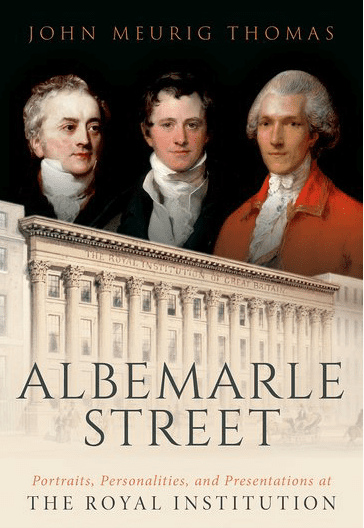Arpan K. Banerjee
Solihull, United Kingdom

Cover of Albemarle Street: Portraits, personalities and presentations at the Royal Institution by John Meurig Thomas.
In this fascinating book, the late Professor Meurig Thomas, a distinguished chemist, former Master of Peterhouse, Cambridge University, and an accomplished popularizer of science, tells the story of one of Britain’s greatest scientific institutions, which for over 200 years has been responsible for many of the great scientific advances of the nineteenth and twentieth centuries and a venue where great scientists have lectured to increase the public awareness of science. The author himself served as a director of this institution and his personal recollections and reminiscences about many of the scientific personalities of his time provide important material for future scientific historians.
Albemarle Street in the heart of the fashionable Mayfair district of London is the home of the venerable Royal Institution, which has been there since 1799. The Royal Institution was founded by the well-connected, American-born Count Rumford, a brilliant maverick inventor and scientist and generous benefactor to the Royal Society of London. To this day, an eponymous medal is awarded in his honor.
The purpose of the Royal Institution was to found a venue in London with a lecture theatre for the dissemination of scientific knowledge to the public, in addition to providing laboratory and office space and a library for scientists, especially in the fields of physics and chemistry.
The first director was Sir Humphrey Davy (appointed Professor of Chemistry in 1802), the scientific genius who first isolated the elements sodium, potassium, calcium, and barium; discovered the anesthetic properties of nitrous oxide (laughing gas); and invented the miner’s safety lamp. He was also interested in poetry and was friends with William Wordsworth and Robert Southey. His contemporary at the Royal Institution was Thomas Young, who had been brought in by Rumford as a professor of natural philosophy. It was in 1801 that Thomas Young carried out his famous double slit experiment in which he demonstrated the wave nature of light. Thomas Young, a formidably intelligent polymath, was referred to as “the phenomenon Young” and is considered to be “the last man who knew everything.” He had studied medicine as well as natural history, philosophy, mathematics, and optics and was fluent in many languages. He made important discoveries in optics and vision, discovered astigmatism, and laid the foundations for understanding color vision. He was also instrumental in identifying the hieroglyphics on the Rosetta Stone.
The Royal Institution was also where Michael Faraday, discoverer of electromagnetic induction, did his groundbreaking experiments on electricity and magnetism. He was director from 1825. One of his great achievements was the founding of the Friday public discourse lectures here, as well the famous Christmas lectures for children that continue to this day. The latter have been broadcast on British television since 1966.
The stellar achievements of Lord Rayleigh, the Nobel Prize-winning physicist (the second Cavendish Professor of Physics at Cambridge), discoverer of argon, and professor of natural philosophy at the Royal Institution remind us of the days of classical physics and the dominance of the famous Cavendish laboratories in Cambridge.
Advances made in molecular biology by scientists from this institution (and their involvement with the Lab of Molecular Biology, Cambridge) as well as the communication of this new field in the public lectures provides a fascinating insight into the work of other scientific giants such as the Braggs (both father and son), as well as contributions made by J D Bernal, W T Asbury, K Lonsdale, D Hodgkin, J Kendrew, M Perutz, David Philips, and other pioneers. The Royal Institution has been associated with many Nobel laureates, eighteen of whom were also recipients of the Faraday Prize and lectureships. The list of popular lecturers is a who’s who of the great scientists of their eras. Not all the popular lectures, however, were given by scientists. Lecturers have ranged from the painter John Constable to authors J B Priestley and E M Forster, composer Hubert Parry, violinist Yehudi Menuhin, and polymath and theatre and opera director Jonathan Miller amongst others.
Particularly valuable and interesting in this book are portraits of the personalities and friendships that the author made during his tenure as director of this august institution. His reflective portraits of friendships with Oliver Sacks, Sam Wanamaker, Carl Sagan, Neil McGregor, Brian Pippard, Margaret Gowing, and other invited speakers provide a wonderful insight into these important intellects.
The book is illustrated with both black-and-white and color photos. It is a delight to read, beautifully written, and is both a historical and personal chronicle of an institution that was and still remains a mecca of science communication in Britain.
Albemarle Street: Portraits, personalities and presentations at the Royal Institution
John Meurig Thomas, 2021
ISBN 9780192898005
ARPAN K. BANERJEE, MBBS (LOND), FRCP, FRCR, FBIR, qualified in medicine at St. Thomas’s Hospital Medical School, London. He was a consultant radiologist in Birmingham from 1995–2019. He served on the scientific committee of the Royal College of Radiologists 2012–2016. He was Chairman of the British Society for the History of Radiology from 2012–2017. He is Chairman of ISHRAD and adviser to Radiopaedia. He is the author/co-author of numerous papers and articles on a variety of clinical medical, radiological, and medical historical topics and seven books, including Classic Papers in Modern Diagnostic Radiology (2005) and The History of Radiology (OUP 2013).

Leave a Reply